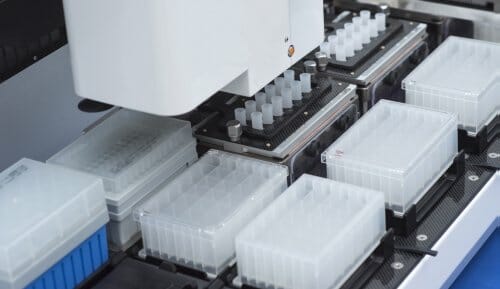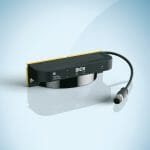A manufacturer of automated analytical equipment for medical technology is using a two-axis linear system to handle samples both quickly and precisely. To help meet sector demands for high performance, the system developer is taking advantage of an assembly based on two NSK Monocarrier linear actuators. The units, which consist of a servo or stepper motor, ball screw and precision guide, arrive pre-assembled and ready for installation.
Blood tests, identifying diseases, doping tests: medical laboratory technology and analytics perform many kinds of task. To undertake analysis, highly automated machines are available that examine samples and reagents at high throughput speeds. Typically, the transportation and handling of the liquids that require analysis takes place individually, in tubes or ampoules, or in microtiter plates with 96 or more wells.
In these machines, the main process is determining the laboratory values of each individual sample. High-performance, high-precision linear systems support this effort on a mechanical level by performing tasks such as dosing reagents into each individual sample, feeding ampoules to the analysis unit or transferring sample carriers from one analysis station to the next. Such systems make it possible to achieve an automated, failure-free workflow with high throughput.
Several leading manufacturers of medical analysis equipment use NSK’s Monocarrier linear actuators for this purpose. The MCM series integrates a high-quality NSK ball screw, servo or stepper motor, U-profile linear guide, bearing units and motor adapters in a compact unit, thus reducing the effort needed for design, assembly and commissioning. The linear guide is equipped as standard with a K1 lubrication unit to ensure long-term, maintenance-free operation, supported further by the use of low-temperature chrome coating to protect against corrosion.
Key features of the NSK Monocarrier include high rigidity and load carrying capacity, smooth motion, precise positioning capability, corrosion resistance, and long service life. MCM series Monocarriers are available in five standard sizes with various stroke lengths and pitches.
The manufacturer of high-end laboratory analysis machines, which are as compact as they are powerful, uses a combination of two Monocarrier MCM systems to unload ampoules from the sample carriers. Fitted to the carriage of the Y axis is an NSK MCM03 series unit, while an MCM02 serves the shorter X axis (NSK provides solutions from the smallest footprint MCM02 up to the MCM10, with strokes ranging from 50 to 1000 mm).
Both axes are equipped with stepper motors (arranged in a U formation to save space) that drive the Monocarrier via a toothed pulley belt. As a point of note, most applications do not require a belt, but instead take advantage of a coupling that facilitates a direct-drive configuration between the motor and MCM unit.
The analyser offers extremely fast throughput in terms of the number of tests than can be performed per hour. NSK Monocarrier units aid this performance by serving an important sub-assembly that continually loads and unloads supplies. As a result, there is no need to stop or pause the machine, ensuring lab technicians can load on the fly while the system continues to run. The reliability of NSK’s linear actuator solution helps the system to operate maintenance-free around the clock, 365 days a year.
NSK supplies the linear system as a ready-to-install pre-assembled unit with other accessories such as sensors and brackets. The linear unit receives its commands from the analyser’s central control system, providing the user with a high-quality solution that is able to handle samples and sample carriers at high speed and precision throughout its entire service life.








